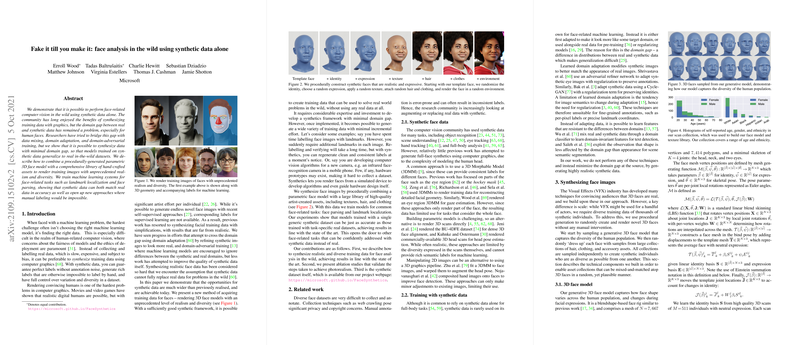Face Analysis Using Synthetic Data: Domain Generalization Without Real-World Data
The paper "Fake it till you make it: face analysis in the wild using synthetic data alone" examines the feasibility of leveraging entirely synthetic data for face-related tasks in computer vision, focusing on tasks such as landmark localization and face parsing, without relying on real-world data. The authors propose a method to synthesize highly realistic and diverse facial training datasets using a procedurally-generated parametric 3D face model.
Methodology
The authors tackle the persistent challenge of the domain gap between synthetic and real data by enhancing the photorealism of synthetic data, thereby minimizing discrepancies at the source. They employ a procedurally-generated 3D face model, compositing it with a comprehensive library of artist-created assets, including textures, hair, clothing, and environmental factors.
The paper reveals an intricate rendering pipeline that utilizes industry-standard techniques such as blendshape-based face rigging, high-resolution texture mapping, photorealistic strand-level hair modeling, and realistic clothing deformation. This allows for the generation of vast amounts of high-variety, labeled training data that includes variables like facial expressions, lighting conditions, and camera perspectives.
Evaluation
The research demonstrates the efficacy of their approach via extensive experimental evaluations on established face analysis benchmarks, namely landmark localization on the 300W dataset and face parsing on the Helen and LaPa datasets. The experiments reveal that models trained solely on the highly realistic synthetic data achieve performance comparable to those trained on real-world data.
Importantly, the paper includes an innovative technique termed "label adaptation" to bridge systematic differences between synthetic and annotated real-world labels. This process aids in aligning the generated models with the subtle nuances often seen in human annotations, thereby further enhancing predictive accuracy.
Strong Results
Numerical results underscore the contribution's effectiveness: landmark localization on the 300W dataset achieves Normalized Mean Error (NME) on par with, or superior to, models trained on real data. For face parsing, results on the LaPa dataset show close accuracy to state-of-the-art models without real data dependency.
Implications and Future Directions
The implications of this research are profound, suggesting that future AI systems could be designed and evaluated extensively on synthetic data, potentially redefining data acquisition strategies within the computer vision community. It opens avenues for tackling privacy concerns, annotation biases, and logistical difficulties associated with conventional data collection processes.
The methodology presented in this paper could foster further research into multi-domain transfer learning, advancing the pursuit of fully autonomous facial recognition systems that can easily adapt to unseen, wild scenarios without requiring recalibration.
Future work may delve into extending the procedural asset library to address limitations such as modeling more complex interactions between clothing and underlying facial structures or enhancing expression realism with dynamic wrinkling models. Moreover, further innovation in reducing the environmental and financial costs of synthetic data generation could considerably democratize access to large-scale labeled data, advancing equity in machine learning research.
In summary, this paper provides a robust framework and solid empirical evidence for the potential of synthetic data to substitute real data entirely for facial analysis tasks in computer vision. It is an informative addition to ongoing discussions on ethical, scalable, and efficient AI model training methodologies.
